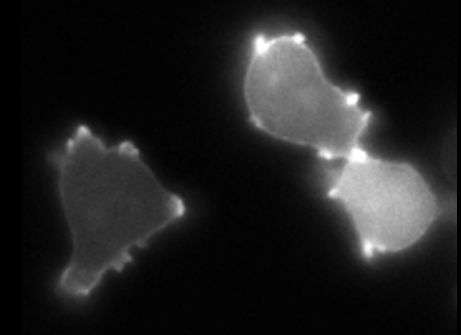Where cells go: Mechanical and chemical cues collaborate to guide them

Living cells respond to biochemical signals by moving toward those at higher concentration, a process carefully mapped out by biologists over the past several decades. But cells also move in response to mechanical forces, such as bumping up against other objects—although the details of that action have been poorly understood. Now, results of a new study, published Nov. 7 in the journal PNAS, reveal that cells use the same network of molecules to react to both chemical and mechanical signals, allowing them to combine potentially conflicting signals into a unified path.
Because cell movement is crucial during embryonic development, tumor metastasis, wound healing, and immune cell response to bacteria and viruses, the findings take scientists one step closer to understanding these biological processes, the researchers say.
"In real life, chemical signals don't occur in isolation," says Peter Devreotes, Ph.D., the Isaac Morris and Lucille Elizabeth Hay Professor of Embryology at Johns Hopkins. "Our experiments help explain how they can receive directional cues from multiple sources and integrate them to guide their movement."
Devreotes' research team built on its earlier studies of cell movement in response to chemical signals, a process called chemotaxis. Working with the single-celled amoeba Dictyostelium discoideum, which uses fingerlike projections to move around, the team mostly examined the actions of amoebae free floating in flasks, but Yulia Artemenko, Ph.D., a former postdoctoral fellow in Devreotes' lab, wanted to watch the process in cells adhering to a surface, as they would be in their natural environment. For the new study, she put a few of the organisms into two dishes and waited for them to attach to the surface. Then, she added a chemical cue, cAMP, to one dish and gently rocked it to distribute the signal; to the other, she added nothing but still rocked it as a control.
To her surprise, she reports, the response of the cells in both dishes was identical. After ruling out possible mistakes, the team began to suspect that the cells in the control dish were reacting to the mechanical flow of the fluid—called shear stress—in the same way they normally respond to the chemical cue.
To verify that hypothesis, the researchers subjected the cells to shear stress in a special chamber and looked for typical chemotaxis responses. Specifically, they analyzed the changing properties of six proteins within the cells using a microscope and found that they followed patterns of localization equivalent to those of cells responding to chemical cues. Then, they biochemically assessed the activities of four other proteins known to be active during chemotaxis and got the same result.
"Cells have about 30 different responses to chemical cues, and we tested more than a third of them," says Devreotes, director of the Department of Cell Biology at the Johns Hopkins University School of Medicine. "Each one looked like a response to a chemical cue but was actually a response to a mechanical cue—in this case, shear stress."
Another hallmark of the cellular response to chemical cues is that its sensitivity repeats in a cycle: Cues must reach a certain level before the system responds, then it responds at its maximum extent, and then it enters an unresponsive period before it can respond again. When subjected to shear stress, the cells exhibited the same behavior, Devreotes says. Not only that, if they were given a mechanical cue, they were unresponsive to chemical cues until that unresponsive period expired.
More information: Yulia Artemenko et al. Chemical and mechanical stimuli act on common signal transduction and cytoskeletal networks, Proceedings of the National Academy of Sciences (2016). DOI: 10.1073/pnas.1608767113
Journal information: Proceedings of the National Academy of Sciences
Provided by Johns Hopkins University School of Medicine





















